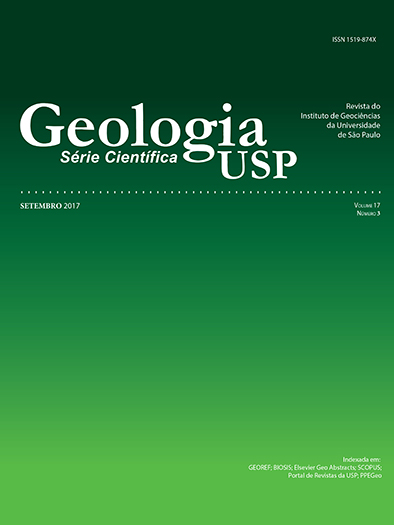Front San Diablo na região de Miraflores, Faixa Sunsás, Bolívia: implicações tectônicas e estratigráficas
DOI:
https://doi.org/10.11606/issn.2316-9095.v17-384Palavras-chave:
Front San Diablo, Terreno Paraguá, Faixa Sunsás, Geocronologia U-Pb, tectônica.Resumo
O Front San Diablo trata-se de uma megaestrutura tectônica desenvolvida nas rochas do Terreno Paraguá e pela cobertura metassedimentar do Grupo Sunsás. Os dados geológicos e geocronológicos obtidos neste trabalho permitiram correlacionar os litotipos descritos na região estudada a três unidades litoestratigráficas: o Complexo Chiquitania, formado por biotita gnaisses de composição monzogranítica a granodiorítica; a Suíte Intrusiva Pensamiento, representada pelo Granito Colmena, um corpo intrusivo milonitizado de composição monzogranítica, localizado na zona de maior deformação do front; e o Grupo Sunsás, formado por micaxistos e metarenitos. Foram identificadas três fases de deformação: F1 gerou o bandamento gnáissico S1 com trend N-S nas rochas do Complexo Chiquitania; F2 promoveu a transposição do bandamento S1, e deu origem a dobras e à foliação S2 segundo o trend regional E-W; F3 foi marcada por dobras suaves e foliações espaçadas do tipo crenulação (S3) ortogonais ao trend geral das estruturas. Os dados geocronológicos U-Pb (SHRIMP) indicaram idade de cristalização em 1.685 ± 4,9 Ma e provável idade de metamorfismo em 1.111 ± 10 Ma para o gnaisse do Complexo Chiquitania; já os dados U-Pb (LA-ICP-MS) obtidos a partir de zircões detríticos sugerem idade máxima de sedimentação em torno de 1,2 Ga para o Grupo Sunsás, com fontes de idade paleo e mesoproterozoicas. Os dados estruturais caracterizam o Front San Diablo como uma larga zona de cisalhamento com direção NE e movimento direcional destral, gerada durante a Orogênese Sunsás em torno de 1,0 Ga, como indicam os dados K-Ar prévios. A partir dos dados apresentados, sugere-se que o Front San Diablo não se trata de um limite tectônico entre os terrenos alóctones Paraguá e San Pablo, mas sim de uma larga faixa de cisalhamento desenvolvida no Toniano, responsável pela justaposição por meio de movimentos direcionais de blocos crustais no interior do Terreno Paraguá.
Downloads
Downloads
Publicado
Edição
Seção
Licença
Autores que publicam nesta revista concordam com os seguintes termos:
- Autores mantém os direitos autorais e concedem à revista Geologia USP. Série Científica, o direito de primeira publicação, com o trabalho sob a licença Creative Commons BY-NC-SA (resumo da Licença: https://creativecommons.org/licenses/by-nc-sa/4.0 | texto completo da licença: https://creativecommons.org/licenses/by-nc-sa/4.0/legalcode) que permite o compartilhamento do trabalho de forma não comercial e conferindo os devidos créditos autorais da primeira publicação nesta revista.
- Autores têm autorização para assumir contratos adicionais separadamente, para distribuição não-exclusiva da versão do trabalho publicada nesta revista (publicar em repositório institucional ou como capítulo de livro), conferindo os devidos créditos autorais da primeira publicação nesta revista.
- Autores têm permissão e são estimulados a publicar e distribuir seu trabalho online (em repositórios institucionais ou na sua página pessoal) a qualquer ponto antes ou durante o processo editorial, uma vez que isso pode gerar alterações produtivas, bem como aumentar o impacto e a citação do trabalho publicado (Veja O efeito do Acesso Aberto e downloads no impacto das citações).















